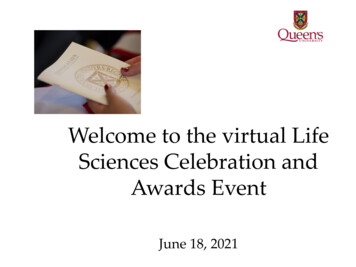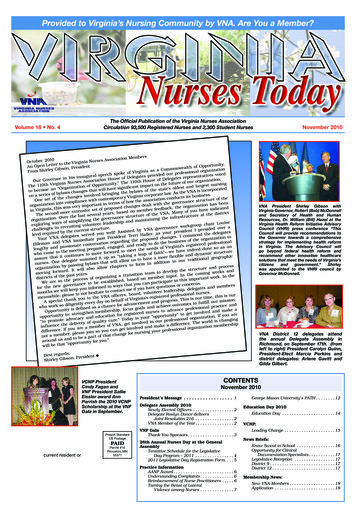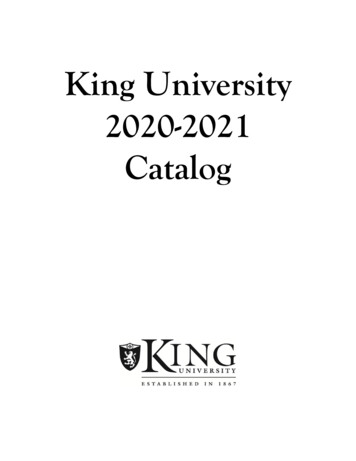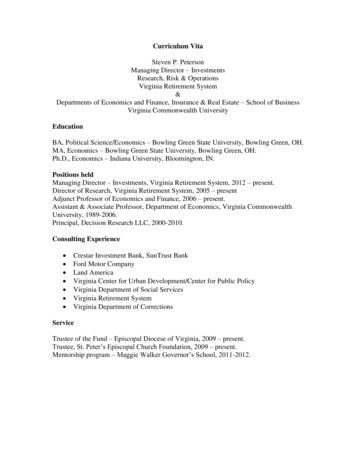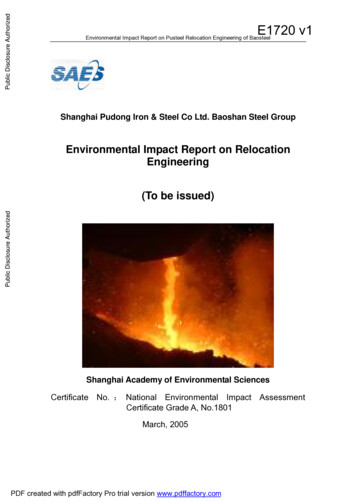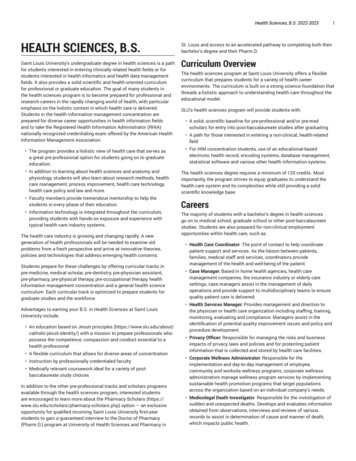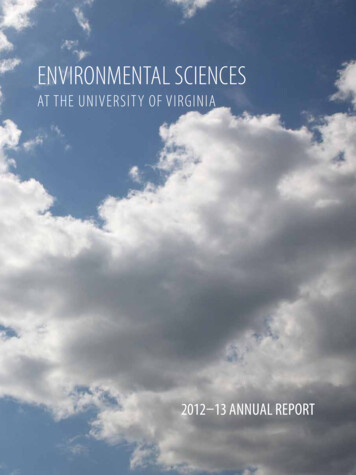
Transcription
Environmental Sciencesat the University of Virginia2012–13 Annual Report
The Department ofEnvironmental SciencesEstablishedin1969, theUniversity of Virginia’s Department of Environmental Sciences was oneof thefirst departments inthenationtolook at fundamental environmental processes froma multidisciplinary perspectiveandthefirst tooffer undergraduate,master’s, anddoctoral degrees inenvironmental sciences. Today, thefaculty includes winners of theprestigiousTyler andHutchinsonAwards as well as fiveprofessors whoareamongthemost highly citedresearchers intheir fields.Departmental fieldstations andfacilities includetheAnheuser-BuschCoastal ResearchCenter inOyster, Virginia, homeof theNational ScienceFoundation–sponsoredVirginia Coast ReserveLong-TermEcological Researchprogram, theVirginia ForestResearchFacility inFluvanna County, andtheBlandy Experimental Farmnear Front Royal, Virginia.Writing and editing: Charlie FeigenoffDesign: RoseberriesCOVER PHOTO: Tom Cogill
From the ChairSome universities focus on research.Others on teaching. At U.Va., they are closelyinterwoven. Members of the University faculty seePhotograph by Tom Cogilleducation as a natural expression of their enthusiasmfor research. At the same time, they view theirresearch activities as an opportunity for hands-oneducation of students. So it is appropriate that thisreciprocal relationship is at the heart of the strategicplan that the University developed this year.The complementary relationship between research and education is as characteristic ofthe department as it is of the University—which is why we are using the five strategic planpillars to organize this report. I can say without exaggeration that we number among ourfaculty some of the world’s most eminent environmental scientists, yet as a group we aredistinguished by our commitment to education.This commitment is quite broad. It includes, as you might expect, our undergraduateand graduate students, but, as this report demonstrates, it also includes students fromother departments and other schools at the University, as well as teachers in primary andsecondary schools, in Virginia and around the globe.Regardless of the circumstance, our goal is the same: to help our students grasp thecomplexity of the environment in which we live and to give them a sense of the disciplineand creativity required for scientific discovery.It is through this work that we hope to train the next generation of environmentalscientists and equip future citizens and leaders to make wise decisions as they confront theenvironmental challenges of the twenty-first century.Patricia Wiberg, Chair
PILLAR 1:Extend and Strengthen the University’s Distinctive Residential CultureJefferson’s advance as an educator was to have students live side by side with professors chosen for theircharacter as well as their intellectual leadership. In our department, we take this educational vision to heart,helping our students grow and mature as scholars and as individuals.ENCOURAGING STUDENT SELF-GOVERNANCEFor as long as she can remember, Melissa Reardon has beeninterested in the environment. While in high school, she startedan environmental club but found the permissions required toorganize activities outside school to be daunting.As a result, when she arrived at U.Va. she was relieved to finda group ready made for her interests, the Environmental SciencesOrganization (ESO). “It helped me feel plugged into the departmentfrom my first month on Grounds,” she says. Today, she is its president.ESO serves a number of functions. As Reardon’s ownexperience shows, it helps new students quickly feel at home inthe department. The club sponsors regular outings—whetherit’s hiking in the Shenandoah National Park or kayaking on theJames River—that make it easier for students to form friendships.It organizes an annual Research Fair, which helps students get toknow faculty members and graduate students. And it provides aready source of academic advice and study partners.In addition, ESO offers an opportunity for students to getinvolved in protecting the environment. In addition to cleaning astretch of Meadow Creek in Charlottesville and participating in ascience fair for elementary school students, the club organizes itsown alternative spring break trip. Last year, club members traveledto Memphis to join a Mississippi River clean-up, while the previousyear they drove to North Carolina to plant trees in the Sandhills.The students themselves organize these activities. The skills theylearn in the process underscore the advantages of the University’stradition of student self-governance. Among other lessons thatReardon says she and her cabinet have absorbed is that delegationis a key attribute of leadership and that flexibility is essential whenworking with a diverse group of volunteers.Reardon believes that her experience with ESO and theseinsights will prove valuable in the future. Reardon herself envisions acareer in environmental consulting. “Thanks to my efforts with ESO,I’ll approach my first job knowing what it’s like to work togetheron a project with a team of people and meet deadlines,” she says.Melissa Reardon (left), the president of theEnvironmental Sciences Organization, kayakingon the James River with the club.2Environmental Sciences atthe University ofVirginiawww.evsc.virginia.edu
Photograph by Stephanie GrossProfessor Mike Pace works closely with doctoral candidate David Seekellto help him develop the skills he needs for a successful career.MENTORING GRADUATE STUDENTSQuite naturally, Environmental Sciences Professor Mike Pace’sapproach to training graduate students is shaped by his ownunderstanding of what’s required to be a successful researcher.At the same time, he feels it is essential to work with his studentscollaboratively. “I try to be sensitive to what they want and wherethey see their careers going,” he says.One of the first lessons he conveys is the amount of carefulthought necessary before starting a research project. Duringtheir first year, Pace engages students in an extended discussion,reviewing the research activities under way in his lab and helpingthem home in on a problem that interests them. He then guidesthem as they refine the problem into a scientific question that ispossible to answer. “Once you have the question clearly in mind, it’seasier to go after it,” he says. “This is a fundamental scientific skill.”Doctoral candidate David Seekell found his question in along-term project that Pace is conducting on ecosystem change.Pace is part of a group of scientists trying to determine the early2012–13 Annual Reportsigns of a shift before an ecosystem reaches a tipping point.They are using two paired lakes in Wisconsin to conduct theirexperiment, inducing a regime change in one by changing its fishcommunity and using the other as a control.Borrowing a statistical test from economics, Seekell isdeveloping easily understood thresholds that environmentalmanagers might use to anticipate an impending regime change.He has found, at least in this case, that the rate at which indicatorsvary, rather than the amount of variation, is a predictor of a shift.Another skill that Pace emphasizes with his graduatestudents is good writing, which he calls “essential but oftenunderappreciated.” Seekell is particularly grateful for the guidance.“Mike worked closely with me on my first paper, and it must havebeen agonizing for him,” he says. “But thanks to the time he putin, I can produce them faster and more fluidly. Succeeding as aresearcher means being able to communicate your findings. Mike’sgiven me the tools to do so.”Environmental Sciences atthe University ofVirginia3
Photograph courtesy of Art SchwarzchildLaura McGowan, a teacher at Occohannock Elementary School in Northampton County,painting in the salt marsh as part of an Art and Ecology Professional Development Workshop.PILLAR 2:Strengthen the University’s Capacity to Advance Knowledge and Servethe Public through Research, Scholarship, Creative Arts, and InnovationThomas Jefferson could have built yet another ivory tower. Instead, he created what he called his AcademicalVillage, which is both open to the public and serves the public. Through interactions with those outside theacademic environment, the department hopes to foster an informed citizenry that appreciates the role thatscience can play in addressing the environmental challenges we face.AN ARTISTIC PERSPECTIVE ON ECOLOGYTravelers to the Eastern Shore are inevitably struck by the beautyof a landscape that is defined by its intersection with the water,a landscape characterized by constant motion and change. Thescientists who visit the department’s Anheuser-Busch CoastalResearch Center use the tools of their profession—box and arrowdiagrams and mathematical simulation modeling, for instance—to better understand the natural systems that produce such beauty.Artists take a more visceral approach and use differentinstruments—paintbrushes and drawing pencils—to exploreand record the natural world. In an effort to bring these twovisions together, the Virginia Coast Reserve Long-Term EcologicalResearch program offers the Art and Ecology ProfessionalDevelopment Workshop for public school teachers.“Art and science are often viewed as unrelated or evenconflicting disciplines,” notes Art Schwarzschild, the center’s sitedirector and the founder of the program. “As these workshopsdemonstrate, they are both similar and complementary.”These two-day programs combine lectures and discussionsabout the environmental processes shaping the Eastern Shore withinstruction on plein air, or outdoor, painting or observationaldrawing. Schwarzschild and Linda Blum, a research associate4Environmental Sciences atthe University ofVirginiaprofessor in the department, focus on the science. Alice McEnerneyCook, a teacher and artist, provides insight into artistic techniquesthrough lectures and one-on-one instruction.In addition to sharpening the skills of the participants,Schwarzschild has another goal for the workshop. He sees thepaintings and drawings the participants create as the ideal vehiclefor increasing public awareness of coastal habitats and the valuableecosystem services they provide. The artwork and essays createdduring the workshops are used to create exhibitions that havetraveled around the state.One measure of the workshop’s success is that participatingartists feel that it has enhanced their appreciation of the world.“Learning the science of the place you are painting makes it moremeaningful,” says Laura McGowan, an art teacher at OccohannockElementary School in Northampton County.Scientists are also changed by the experience. Schwarzschild,who categorizes his own attempts at plein air painting as “bothfrustrating and exhilarating,” says that interacting with art teachersattending the workshops has given him the opportunity to see saltmarshes through their eyes. “It will forever alter the way I describethese fragile yet resilient landscapes,” he says.www.evsc.virginia.edu
KEEPING SCIENCE TEACHERS CURRENTBy the time discoveries in the geosciences appear in primaryand secondary school textbooks, they are no longer so new.Professor Steve Macko joined the Committee on Education ofthe European Geosciences Union (EGU) to help shorten thetime between discovery and classroom discussion. Since 2003,the committee has organized an annual three-day GeosciencesInformation for Teachers (GIFT) workshop, featuring talks byleading earth scientists.“Our goal is not simply to familiarize teachers with the mostcurrent science,” Macko says. “We also want them to share inthe excitement we feel as researchers, a feeling that we hope theyconvey to students in their schools.”“We want them to share in the excitement we feelas researchers, a feeling that we hope they convey tostudents in their schools.”If You’re InterestedThe topic for GIFT 2014 is “Our Changing Planet.” The workshopswill feature discussions of the soon-to-be-released findingscontained in the Fifth Assessment Report of the IntergovernmentalPanel on Climate Change. A link to applications can be found athttp://www.egu.eu/outreach/gift/.Photograph by Tom CogillThe topic of the workshops varies from year to year. The 2013workshop focused on natural hazards, with presentations about theintersection of the built environment with such natural phenomenaas earthquakes, volcanic eruptions, and tsunamis. This most recentprogram attracted eighty teachers from across Europe, as well asChina, Japan, and the United States. Since the workshop’s inception,well over a thousand teachers worldwide have attended them.“The EGU considers GIFT an important element in itsstrategy of preparing the next generation of scientists andinformed citizens,” Macko says. This year, Günter Bloeschl, thepresident of the organization, welcomed the participants. Andthe program is scheduled so participants have the opportunity toattend the EGU annual general assembly.Macko is committed to the program because he seeseducation and outreach as a natural expansion of his science.“Researchers have a responsibility to stimulate others, especiallystudents, to ask questions and seek answers,” he says. He viewsworking with some of the best teachers in the world as an effectiveway to leverage his information and enthusiasm.“The GIFT program operates at the interface betweencutting-edge science and cutting-edge teaching,” Macko says. “Itis through the work of these teachers that the public will betterunderstand the role of science in helping society address pressingenvironmental problems.”For Professor Steve Macko, educating teachers isa powerful way to leverage his knowledge of theenvironment and his enthusiasm for science.2012–13 Annual ReportEnvironmental Sciences atthe University ofVirginia5
Photograph by Tom CogillThanks to a partnership between the University and the National Fish and Wildlife Foundation, graduate student Atticus Stovall hasgained a greater appreciation for the challenges facing professional conservationists.Pillar 3:Provide Educational Experiences That Deliver NewLevels of Student EngagementThe University’s strategic plan calls for innovations in education that encourage students to internalizeknowledge and make it their own. In our department, one of the ways we do this is by creating opportunitiesfor students to conduct their own research.COMING FACE TO FACE WITH CONSERVATION PROFESSIONALSTwo years ago, the University joined forces with the National Fishand Wildlife Foundation (NFWF) to offer an advanced courseon biodiversity conservation science and policy. This marked thebeginning of a productive collaboration for both organizationsthat includes summer internship and fellowship programs.Graduate student Atticus Stovall is one of its beneficiaries.A nonprofit organization chartered by Congress, NFWFtackles conservation issues, develops guidelines and specifiesoutcomes, and provides grants to public- and private-sectororganizations to achieve these goals. It turned to the University tohelp provide the scientific guidance it needs to direct its fundingeffectively. For its part, the University saw the collaboration as anopportunity to align its research agenda with national needs and toexpose students to strategies being used to preserve biodiversity.Stovall signed up for Science and Policy of BiodiversityConservation, a seminar offered jointly by the School of Law andthe department, when he was an undergraduate. Instructors dividethe students into multidisciplinary teams, each assigned to makerecommendations about an ongoing NFWF project. Foundationstaff involved in these initiatives come to Charlottesville and6Environmental Sciences atthe University ofVirginiaintroduce students to their work. “During the seminar, students getexposure to the challenges conservation professionals face,” saysProfessor Hank Shugart, one of the faculty members for the course.Stovall studied the foundation’s bobwhite quail restorationproject. Formerly abundant throughout the Southeast, the bobwhitequail are endangered by the introduction of cool-season grasses,which have transformed their habitat. Stovall and his team proposedtargeting farmers to spearhead warm-season-grass restoration. “Wefelt this approach could have more impact because farmers are usedto dealing with landscapes at large scales,” he says.NFWF also selected Stovall, now a graduate student, for apaid internship. He helped the foundation develop a GIS-basedmodel that prioritizes funding opportunities for longleaf pinerestoration sites in North Carolina. As part of his analysis, heattended a conference in southwest Georgia that brought togetherthe top stakeholders in the project. “That might have been themost definitive moment in my career thus far,” he says. “It helpedme understand that to develop a coherent, efficient approach tosolving a problem, you need to bring everyone involved together.”www.evsc.virginia.edu
Professor Stephan De Wekker turned the development of an unmanned aerial vehicle for atmospheric observations into a student project. From left to right, environmentalsciences graduate student Stephanie Phelps, Rahul Mukherji, De Wekker, and Nikita Dodbele. Mukherji and Dodbele are fourth-year engineering students.REMOTE-CONTROLLED ATMOSPHERIC OBSERVATIONSOur lives unfold in the atmospheric boundary layer, the portionof the atmosphere directly influenced by the Earth’s surface. It’sa dynamic zone. The cool breeze coming down off a mountain ona summer evening and the snow accumulating downwind from alake in winter are all the result of boundary layer processes.Their assignment: build a hexacopter from scratchand equip it with sensors.Associate Professor Stephan De Wekker focuses on the wayterrain and vegetation shape these processes. Currently, one ofhis principal research tools is a tethered helium balloon, whichhe equips with sensors to register changes in such variables astemperature and humidity as well as wind speed and direction.But as De Wekker points out, helium balloons have theirdrawbacks. They are time-consuming to set up and sometimesdifficult to control. De Wekker learned that Doug Chestnut, a Webprogrammer in the University Library, had been using remotecontrolled, multirotor vehicles for aerial photography. He decidedthat these devices could be adapted for atmospheric profiling.2012–13 Annual ReportAt the same time, De Wekker sensed an educationalopportunity. “I thought the process of adaptation would beinteresting to engineering students,” he says. “I sent out anannouncement describing our goals and asking for an assistantwho would be paid a nominal salary.” Their assignment: build ahexacopter from scratch and equip it with sensors. De Wekkerreceived so many volunteers that he ended up hiring four students.“At the end of the summer, the students had built theirfirst flying prototype and had conducted an assessment of theavailable sensors,” De Wekker says. “They also worked on systemsthat would enable the copter to communicate real-time data toground stations.”As word of De Wekker’s project got out, he was approached byGreg Lewin, a lecturer in the Department of Systems Engineering,and representatives of the Mitre Corporation, who were interestedin integrating the hexacopter development project into theEngineering School’s Capstone program. “The next step will beto create a copter capable of autonomous, scheduled flight,” DeWekker says. “You could put it someplace, and it could take a seriesof observations on its own. That would be great.”Environmental Sciences atthe University ofVirginia7
Pillar 4:Assemble and Support aDistinguished FacultyA distinguished faculty is the startingpoint for a virtuous cycle that leadsto better undergraduate and graduatestudents, higher research funding, andmore engaged and committed alumni.The department is well placed in thisregard. Our faculty includes winners ofthe prestigious Tyler and HutchinsonAwards as well as five professors who areamong the most highly cited researchersin their fields.Associate Professor Matt Reidenbach appliesengineering concepts to coral reef ecology.THE FUTURE OF CORAL REEFSAssociate Professor Matt Reidenbach brings the sensibility of atrained engineer to his investigations of coral reefs, employingsuch traditional engineering concepts as fluid dynamics and heatand mass transfer to illuminate reef ecology. Understanding theirrole is particularly critical in light of climate-driven changes inreef environments, including rising sea levels, increasing watertemperatures, and growing ocean acidity. “The underlyingquestion we are trying to address is how the changes we foreseein the physical environment will affect the health of our reefs,”Reidenbach says.Coral reefs will start to bleach and die off as ambienttemperatures rise. Working with undergraduate Angang Li,Reidenbach has used computer simulations to study Panama’sBocas del Toro reef system. Their investigations show that coralgrowing in shallow areas and in areas with poor water circulationwill feel the effects of rising temperatures first. “The flowenvironment really affects their sensitivity to warming,” he says.8Environmental Sciences atthe University ofVirginiaReidenbach also applies engineering principles tounderstanding the consequences of rising sea levels on sedimenttransport along beaches. His study of reefs off the Hawaiian islandof Molokai suggests that as waters rise and reefs lose their capacityas breakwaters, there will be corresponding changes in sedimenterosion and accretion along shorelines.His analysis is complicated by coral die-off. By couplinghis observations with ecology models, Reidenbach hopes todetermine the effects of coral degradation on sediment budgets.Coral produce calcium carbonate, an important source of sand. Asreefs die off, there will initially be more sand available for beaches,but when they are completely gone, this source of sand willultimately disappear. “We’re trying to tie the physical models tothe ecological models so we can become better at predicting thesefuture scenarios,” he says. “If you build a hotel on a nice sandybeach, you’re going to want to know if that beach will be there intwenty years.”www.evsc.virginia.edu
Paolo D’Odorico is conducting pioneering research to determine thelimits of global trade in evening out disparities in water resources.WORLD WIDE WATERPaolo D’Odorico’s career illustrates both the inherentlyinterdisciplinary nature of the environmental sciences and thegrowing breadth of his interests as a researcher. The Ernest H. ErnProfessor of Environmental Sciences, D’Odorico is a hydrologistfocusing on arid and semi-arid regions as well as wetlands, often inconjunction with atmospheric scientists, geologists, and ecologists.In fact, he is considered a pioneer in a subspecialty calledecohydrology. And while he continues to devote himself to theseprojects, D’Odorico has also begun to consider water issues morebroadly. An emerging theme in his work is societal reliance onwater resources and the globalization of these resources associatedwith the trade of food commodities.“There have always been technological advances thatenabled farmers to feed more people.”Thanks to the range of his interests, the University namedD’Odorico as one of the first two recipients of the its DistinguishedResearch Career Award. This new award is now the University’smost prestigious—and certainly its largest—grant for research,totaling 150,000 over three years.2012–13 Annual ReportD’Odorico will use these funds to continue his investigationsinto how water limitations could constrain food production andslow global population growth. “The idea that the availabilityof natural resources could restrict population growth is an oldone,” he says. “But there have always been technological advancesthat enabled farmers to feed more people.” The latest innovationthat D’Odorico cites is the growth of global trade, which allowspeople in countries where water is in short supply to import foodproduced in countries where water is more abundant.Because food production accounts for nearly 80 percent offreshwater use, water shortages can easily disrupt this trade. Intimes of drought, water-rich countries lack surplus food for export.In response, water-poor countries have been trying to guaranteetheir food supplies by acquiring productive land in water-richcountries.With the system stretched so thin, these efforts will eventuallycome up against a limit. D’Odorico’s goal is to develop a generalmodel that would help identify that point. “Most people thinkthe water crisis is about a thirsty humanity,” D’Odorico says.“Ultimately, it is about a hungry humanity.”Environmental Sciences atthe University ofVirginia9
Pillar 5:Steward the University’s Resources to Promote Academic Excellenceand Affordable AccessFor an educational institution, wise stewardship means devoting its resources efficiently to create opportunityfor learning and discovery. One way the department does this is by providing fellowships for graduate research,where relatively small sums can make a big difference. Creating these opportunities, however, requires soundmanagement. For this, the department relies on the skill and judgment of its committed staff.MAKING THE COMPLICATED SEEM EASYWhen David Hondula, now a postdoctoral fellow at ArizonaState University, submitted his dissertation this year, he madea point of acknowledging the department’s staff. “They have madethe administrative aspects of graduate school as streamlined aspossible,” he wrote. He thanked them “for making the complicatedseem easy and the last minute seem like a long one.”In conveying his appreciation, Hondula simply expressed thehigh regard that is widely shared throughout the department. “I amgrateful every day for the excellent staff we have in EnvironmentalSciences,” says Professor Patricia Wiberg, the department chair.“We depend on their knowledge and dedication to keep thedepartment running.”One reason that the department staff is so strong is itswork ethic. Henry White, senior fiscal technician, is constantlylooking for ways to learn more—about his job and those ofhis colleagues—so he can carry out his responsibilities moreeffectively. But White doesn’t limit himself to managing thedepartment’s sponsored research funding. Before the departmentmoved to New Clark Hall, he helped pack up boxes and clean outoffices so the construction could continue in Old Clark.As assistant to the department chair, Cindy Allen supportsthe department’s academic mission. As she says, “I don’t makedecisions; I help make decisions happen.” She welcomes the diversechallenges of the job—and she especially relishes the opportunityto see a project to conclusion. “It’s really satisfying when you put alot of effort into a project and it comes out well,” she says.Longevity is another reason for the staff ’s effectiveness. White,Allen, and Gerald Williamson, the machine shop supervisor, haveall been with the department for more than ten years. They stay,White and Allen say, because they feel supported. Allen notes thatAssociate Chair Dave Smith makes sure that “we all have what weneed to do our job and he trusts us to do it well.” And White citesthe staff ’s close and cordial relationship with faculty as anotherreason. “They respect and value what we do,” he says.Gerald Williamson, Cindy Allen, andHenry White have all served thedepartment for more than a decade.10Environmental Sciences atthe University ofVirginiawww.evsc.virginia.edu
SUPPORTING MORE-PRODUCTIVE GRADUATE RESEARCHFor a graduate student there is nothing more important—ormore nerve-wracking—than working on a master’s thesis ordoctoral dissertation. After years of classroom study, studentsapproach these projects as a first opportunity to make anindependent contribution to scientific knowledge.The department strives to provide these apprenticeresearchers with the support they need. In addition to guidancefrom faculty advisors, the department offers grants to help studentsconduct the preliminary research and to complete their projects.Each year, students compete for Exploratory Research Awards andmore substantial Moore Research Awards.Heather Sullivan’s Exploratory Research Award will enableher to use stable isotopes to determine residence times of plasticdebris in surface ocean waters. “Large quantities of plastic findtheir way into our oceans each year” she says. “The environmentalconsequences are vast, ranging from entanglement of marine faunato the widespread distribution of toxic compounds produced asplastic degrades.”Sullivan is experimenting with using isotope analysis ofdegrading plastic as a geochronometer, giving researchers a senseof the approximate time that the plastic has been in the ocean.Working with Professor Steve Macko, she is comparing plasticdegradation in freshwater and marine environments. “It happensremarkably quickly in saltwater,” she says.Alia Al-Haj received a Moore Research Award to develop datathat help guide the eelgrass restoration project currently underway in Hog Island Bay, part of the Virginia Coast Reserve. Untilthe hurricane of 1933 completed the work of a wasting disease,the bottom of Hog Island Bay had been covered by eelgrass.Researchers at the department’s Long-Term Ecological Researchprogram and the Virginia Institute of Marine Science are reseedingthe bay, giving them an opportunity to assess the ecosystem-leveleffects of a rapid return to its original state.Working with Professor Karen McGlathery, Al-Haj isdetermining how the maximum and minimum depths for eelgrasschange depending on the light environment in the water columnand its temperature. She used her Moore Research Award topurchase sensors she needed to conduct her experiments. “Supportfrom the department was really important,” she says. “It enabledme to create a model that could be applied to the restoration.”Heather Sulliva
Established in 1969, the University of Virginia's Department of Environmental Sciences was one of the first departments in the nation to look at fundamental environmental processes from a multidisciplinary perspective and the first to offer undergraduate, master's, and doctoral degrees in environmental sciences.

